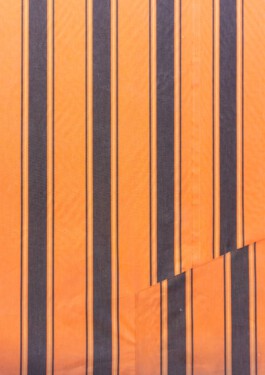Arheilgen
Mathias Weinfurter
Arheilgen is the suburb where Mathias Weinfurter is currently living and working as a Charlotte Prinz Fellow of the city of Darmstadt. With this title, he locates his works at the site where they are produced, without however giving up his consequent claim to their universality. For him, ‘Arheilgen’ stands for every other location in the (German-speaking) province: any random suburb or village, that could also be called something else, and in which carefully-tended front gardens, as well as single- and multi-family houses line up in rows.
It is the allegedly generic details of such places that interest Weinfurter: the twin wire mesh fence that appears in his work again and again. Roughcast plasterwork, that predominantly was used in the 1960s to the 1980s, in this manner or similarly, millions of times. Window awnings in brown and orange that provided shade for millions of people in post-war Germany and Austria. The reliefs composed from these elements awake associations with personal feelings and stories, and equally with political events that took place in front of and behind these façades. Even when these experiences are individually different – some fell in love below such awnings, others quarrelled – they occurred in front of the same backdrop.
For Weinfurter, who grew up near the former capital city Bonn, the involvement with the surfaces of old West Germany is also always socio-political. In defamiliarizing and newly composing the textures, he indicates the ambivalence of this legacy. This society, until today, does not offer prosperity and security for everyone. Distortions and cracks appear in the familiar architecture, behind which the chasms of marginalization, violence, and poverty loom.
“Arheilgen” is the third sequence in a series of reliefs by the sculptor. For the autobiographical work “Ankerstraße” (Moltkerei Werkstatt, Köln, 2023) as well as for “Solitär” (Kunsthalle Darmstadt, 2025), he played with industrially-produced concrete façades of large-scale housing complexes for the working class. Now, it is the “Munich roughcast” that adheres to the (lower)middle class single-family houses. This material is only uniform at first glance: while it is being worked, small pebbles create irregular cracks in the damp plaster, so that an individual structure always results. In this way, the surface provides evidence of the work of an individual person. The awning thereby functions as a socially connecting element: it is found on terraced houses as well as on apartment blocks.
What drives Weinfurter is the search for formulas and elements, in order to bring people together - together in a consideration of the everyday, in common recollections and imaginings of a good life in the here and now, in which there are increasingly fewer and fewer of them.
Text by Nils Altland
05.06. - 26.07.2025
Opening: 05.06.2025, 6 pm
KOENIG2, Margaretenstr. 5, 1040 Vienna, Austria

Arheilgen
Mathias Weinfurter
Arheilgen is the suburb where Mathias Weinfurter is currently living and working as a Charlotte Prinz Fellow of the city of Darmstadt. With this title, he locates his works at the site where they are produced, without however giving up his consequent claim to their universality. For him, ‘Arheilgen’ stands for every other location in the (German-speaking) province: any random suburb or village, that could also be called something else, and in which carefully-tended front gardens, as well as single- and multi-family houses line up in rows.
It is the allegedly generic details of such places that interest Weinfurter: the twin wire mesh fence that appears in his work again and again. Roughcast plasterwork, that predominantly was used in the 1960s to the 1980s, in this manner or similarly, millions of times. Window awnings in brown and orange that provided shade for millions of people in post-war Germany and Austria. The reliefs composed from these elements awake associations with personal feelings and stories, and equally with political events that took place in front of and behind these façades. Even when these experiences are individually different – some fell in love below such awnings, others quarrelled – they occurred in front of the same backdrop.
For Weinfurter, who grew up near the former capital city Bonn, the involvement with the surfaces of old West Germany is also always socio-political. In defamiliarizing and newly composing the textures, he indicates the ambivalence of this legacy. This society, until today, does not offer prosperity and security for everyone. Distortions and cracks appear in the familiar architecture, behind which the chasms of marginalization, violence, and poverty loom.
“Arheilgen” is the third sequence in a series of reliefs by the sculptor. For the autobiographical work “Ankerstraße” (Moltkerei Werkstatt, Köln, 2023) as well as for “Solitär” (Kunsthalle Darmstadt, 2025), he played with industrially-produced concrete façades of large-scale housing complexes for the working class. Now, it is the “Munich roughcast” that adheres to the (lower)middle class single-family houses. This material is only uniform at first glance: while it is being worked, small pebbles create irregular cracks in the damp plaster, so that an individual structure always results. In this way, the surface provides evidence of the work of an individual person. The awning thereby functions as a socially connecting element: it is found on terraced houses as well as on apartment blocks.
What drives Weinfurter is the search for formulas and elements, in order to bring people together - together in a consideration of the everyday, in common recollections and imaginings of a good life in the here and now, in which there are increasingly fewer and fewer of them.
Text by Nils Altland
05.06. - 26.07.2025
Opening: 05.06.2025, 6 pm
KOENIG2, Margaretenstr. 5, 1040 Vienna, Austria
